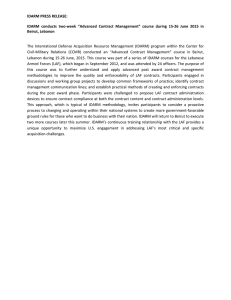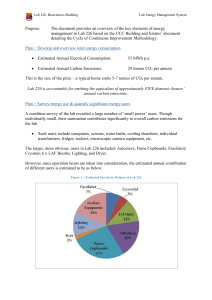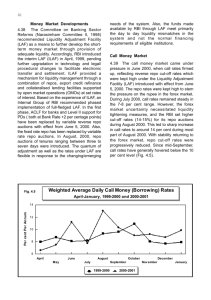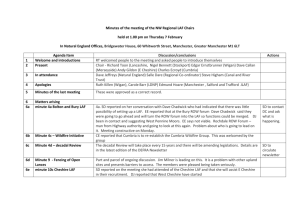High resolution X-ray scattering investigation of Pt/LaF /Si(1 1 1
advertisement
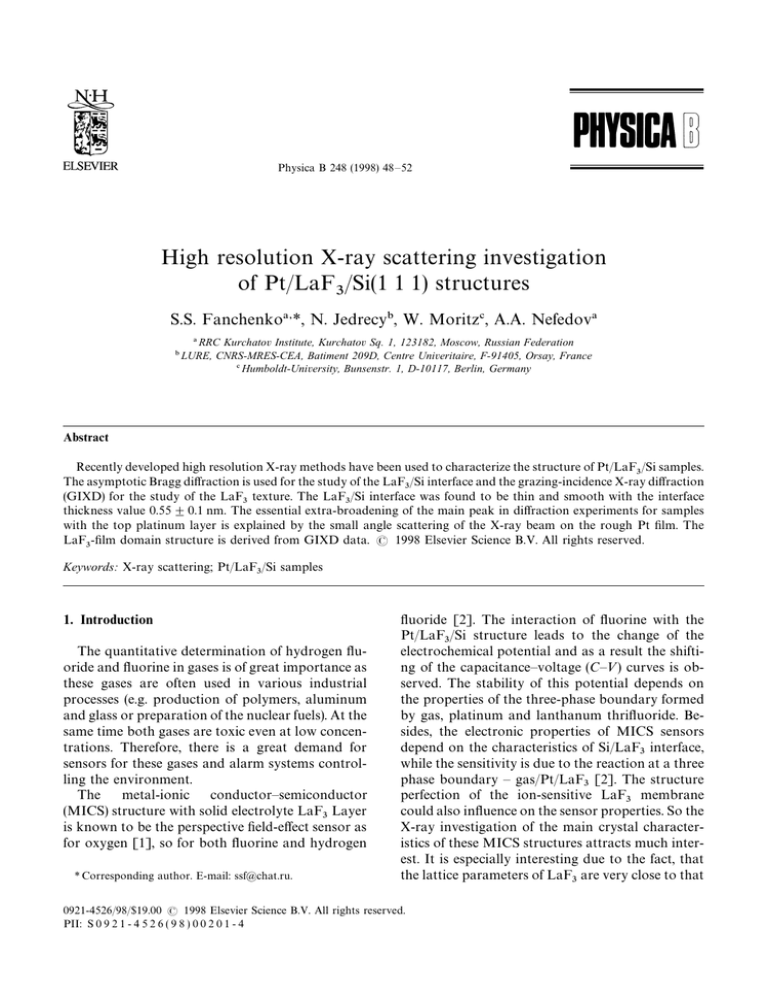
Physica B 248 (1998) 48—52 High resolution X-ray scattering investigation of Pt/LaF /Si(1 1 1) structures 3 S.S. Fanchenko!,*, N. Jedrecy", W. Moritz#, A.A. Nefedov! ! RRC Kurchatov Institute, Kurchatov Sq. 1, 123182, Moscow, Russian Federation " LURE, CNRS-MRES-CEA, Batiment 209D, Centre Univeritaire, F-91405, Orsay, France # Humboldt-University, Bunsenstr. 1, D-10117, Berlin, Germany Abstract Recently developed high resolution X-ray methods have been used to characterize the structure of Pt/LaF /Si samples. 3 The asymptotic Bragg diffraction is used for the study of the LaF /Si interface and the grazing-incidence X-ray diffraction 3 (GIXD) for the study of the LaF texture. The LaF /Si interface was found to be thin and smooth with the interface 3 3 thickness value 0.55$0.1 nm. The essential extra-broadening of the main peak in diffraction experiments for samples with the top platinum layer is explained by the small angle scattering of the X-ray beam on the rough Pt film. The LaF -film domain structure is derived from GIXD data. ( 1998 Elsevier Science B.V. All rights reserved. 3 Keywords: X-ray scattering; Pt/LaF /Si samples 3 1. Introduction The quantitative determination of hydrogen fluoride and fluorine in gases is of great importance as these gases are often used in various industrial processes (e.g. production of polymers, aluminum and glass or preparation of the nuclear fuels). At the same time both gases are toxic even at low concentrations. Therefore, there is a great demand for sensors for these gases and alarm systems controlling the environment. The metal-ionic conductor—semiconductor (MICS) structure with solid electrolyte LaF Layer 3 is known to be the perspective field-effect sensor as for oxygen [1], so for both fluorine and hydrogen * Corresponding author. E-mail: ssf@chat.ru. fluoride [2]. The interaction of fluorine with the Pt/LaF /Si structure leads to the change of the 3 electrochemical potential and as a result the shifting of the capacitance—voltage (C—») curves is observed. The stability of this potential depends on the properties of the three-phase boundary formed by gas, platinum and lanthanum thrifluoride. Besides, the electronic properties of MICS sensors depend on the characteristics of Si/LaF interface, 3 while the sensitivity is due to the reaction at a three phase boundary — gas/Pt/LaF [2]. The structure 3 perfection of the ion-sensitive LaF membrane 3 could also influence on the sensor properties. So the X-ray investigation of the main crystal characteristics of these MICS structures attracts much interest. It is especially interesting due to the fact, that the lattice parameters of LaF are very close to that 3 0921-4526/98/$19.00 ( 1998 Elsevier Science B.V. All rights reserved. PII: S 0 9 2 1 - 4 5 2 6 ( 9 8 ) 0 0 2 0 1 - 4 S.S. Fanchenko et al. / Physica B 248 (1998) 48—52 of the hexagonal Si (1 1 1) surface, so that the epitaxial growth of thin LaF films could be enabled 3 [3]. It was found recently that rather thick (+100 nm) LaF films grown at the room temper3 ature are disordered and become crystalline upon annealing [4]. Besides, the deposition of LaF at 3 high temperatures could lead to the epitaxial growth of the film with the c-axis of the hexagonal unit cell parallel to the Si [1 1 1] direction. 2. Experiments and results 2.1. Sample preparation We have performed several series of measurements for different sets of samples. Semiconductor/ionic conductor structures were produced by growing lanthanum thrifluoride layer on single crystalline silicon (1 1 1) by the thermal vapor deposition technique. The thickness of the LaF layers 3 varied from 5 to 300 nm, the deposition was performed at substrate temperature of 550°C. The Pt/LaF interface should be a three phase bound3 ary in order to provide the Nerstian behavior of the Pt/LaF electrode. This was enabled by DC sput3 tering (10—80 nm) layers of platinum in argon plasma with following thermal annealing at 360°C in air. Several LaF /Si samples were left without the 3 top Pt electrodes in order to test the LaF crystal3 line properties. In the present work we consider the application of the following methods in the investigation of Pt/LaF /Si structures: the asymptotic Bragg dif3 fraction (ABD) [5] or crystal truncation rod [6]— for LaF /Si interface; the grazing-incidence X-ray 3 diffraction (GIXD) [7] — LaF film texture. 3 2.2. ABD experiments The scheme of the ABD-experiment was given in Ref. [5]. The triple crystal scheme is used in this technique and the dependence of diffraction intensity on the analyzer angular position H is investi3 gated at rather large values of the angle a of the sample deviation from the Bragg position. Usually, there are three peaks on the triple crystal curve 49 — the diffuse peak, situated near origin; the pseudopeak, associated with the asymptotic diffraction on the monochromator and situated at H "a, and 3 the so-called main peak, associated with the asymptotic diffraction from the investigated sample and situated at H "2a. Due to the high resolution 3 achieved in this technique, one can investigate the coherent diffraction intensity far from the Bragg position. Experimentally it is done by measuring the main peak area at different a. We used Cu K radiation, Si (1 1 1) reflection and a Si(1 1 1) crystals as monochromator and analyzer. The measured triple-crystal curves for Pt/LaF /Si 3 sample with LaF layer thickness 240 nm and 3 Pt film thickness about 40 nm (curve 1) and for LaF /Si sample with LaF layer thickness 145 nm 3 3 (curve 2) are depicted in Fig. 1a. The main peak could be reliably distinguished from the diffuse background in the both cases and several curves of the main peak are shown in Fig. 1b. The essential extra-broadening of main peak curves for two Pt/ LaF /Si samples (dot—dash and dash lines) com3 pared to the LaF /Si curve (solid line) could be 3 explained by the small angle scattering of the X-ray beam on inhomogeneities of the rough Pt film [8]. In order of simplicity we would consider only Gaussian height-to-height roughness correlation function. In that case the double propagation of the d-shaped beam through the rough layer results in the following variation of the beam shape: I(u)"e~2L2n k2s20P5@4*/2hBd(q)#2e~L2n k2s20P5@4*/2hB ](1!e~L2n k2s20P5@4*/2hB) e~0.5q2L2-¸ /J2p #(1!e~L2n k2s20P5@4*/2hB)2e~q2L2-¸ /Jp, where q"ku cosH ; k"2p/j, j is the wavelength; B H is the Bragg angle; u is the angle of the small B scattering in the diffraction plane; ¸ and ¸ are n the roughness value and lateral roughness correlation lengths, accordingly; s is the platinum polar0P5 izability. The estimations for the sample 1 (dot-dash line) in Fig. 1b have given the following values of parameters: ¸ +¸ +40 nm. Considering that the ton tal thickness of the Pt film is about 40 nm, one can conclude, that this film is really an island-like one. The similar result was obtained for the sample 2 (dash line) too. 50 S.S. Fanchenko et al. / Physica B 248 (1998) 48—52 Fig. 2. The relative diffraction intensity (averaged over three Pt/LaF /Si samples) vs. the angle a of the sample deviation from 3 the Bragg position. The relative intensity curve averaged over three samples data is shown in Fig. 2. The characteristic depth of the distorted region ¸ is determined by $ the angular half-width of that curve D: Fig. 1. Triple-crystal rocking curves for Pt/LaF /Si samples 3 with Pt layer thickness 40 nm, LaF layer thickness 240 nm and 3 LaF /Si samples with LaF layer thickness 145 nm. (a) a"60A 3 3 — Pt/LaF /Si structure — curve 1; LaF /Si structure — curve 2. 3 3 (b) a"360A — two different samples of Pt/LaF /Si structure 3 — dot-dash and dash lines; LaF /Si structure — solid line (only 3 main peaks are shown). The crystal perfection of the LaF /Si interface 3 could be determined from the so-called relative intensity curve (the ratio of the coherent diffraction intensity from the investigated crystal to the one from the ideal crystal) [6]. The distinction of the relative intensity from unity is associated with the crystal structure distortions near surface. Due to the large values of a the kinematic treatment of the diffraction could be used. j ¸" . $ 4pD cos h B The shape of the observed curve is typical for insulator/silicon interfaces, giving the distorted interface thickness value 0.55$0.1 nm. So, the LaF /Si 3 interface structure is characterized by rather small distortions. The weak diffuse peak on the triplecrystal rocking curve for LaF /Si sample without 3 the top Pt film (Fig. 1, curve 2) indicates the negligible amount of the defects located near LaF /Si 3 interface. The shape of the relative intensity curve for these samples was the same as for the samples with Pt film. This fact indicates that the LaF /Si 3 interface is not influenced by Pt-film deposition. 2.3. Grazing incidence X-ray diffraction A 300 nm LaF film grown on Si (1 1 1) was 3 analyzed by GIXD-experiments. The experiment was perfomed with the ultra-high-vacuum 6-circle diffractometer, set on the synchrotron wiggler beam line DW12 of LURE (Orsay, France). Radiation was aligned using a laser beam, and the S.S. Fanchenko et al. / Physica B 248 (1998) 48—52 crystallographic alignment was achieved by use of the Si bulk reflections. The incidence angle was set to the critical value for total reflection. The specular intensity detected with a X-ray camera showed that the surface was homogeneous and quite smooth. Assuming a (0 0 01) surface of LaF , with the 3 azimuthal orientation [1 0 0] LaF //[1 0 11 ] Si 3 (labeled A ), we used the reciprocal-space (RS) lattice (a*, b*, c*) associated to the bulk hexagonal LaF lattice (a"4.148 A_ , c"7.3554 A_ ). A RS posi3 tion will be denoted (h, k, l ), according to the momentum transfer q"2p(ha*#kb*#lc*). The expected reflections from LaF and Si are depicted 3 in Fig. 3a in a (11 1 0) Si cross section of the reciprocal space. Two azimuthal orientations, at 180° from each other along the normal, are possible. However, they cannot be distinguished, the symmetries in the unit cell leading to a rod (h,k) being the same as the rod (hM , kM ). The Fig. 3b presents the rods (1, 0) and (1, 1) from l-scans. The rod (11 , 0) was qualitatively equivalent to the rod (1, 0). According to orientation A , one should observe along rod (1,0) peaks at l"1 and l"3, the atomic configuration in the LaF unit cell producing a very weak reflec3 tion at l"2. In the case of the rod (1, 1), as there is an extinction for all reflections at l odd, one expects one peak at l"2. The experimental l-scans confirm the epitaxial relationship, but reveal extra peaks, at l"0.7, 1.4, 3.6, on the rod (1, 0) (see Fig. 3b), and at l"3.2 on the rod (1, 1). The integrated intensities for each l value were derived from H-scans and corrected by the active sample area, the Lorentz and the polarization factors. The intensities of the reflections at integer l values agree with those calculated for the atomic model, known from literature. The correlation length was evaluated as 150 A_ . This limited value for such a thick film indicates the existence of multiple distorted regions. In fact the availability of other orientations results in the limiting of the width of the domains oriented as A . Due to that fact the extra peaks detected in 1 the (1, 0) l-scan are weakened, so some other l-scans were performed at (h, k) values close to (1, 0), that is after slight rotation of the sample along its normal surface, in order to characterize these extra peaks. After a 1° rotation from the Bragg position, the peaks at l"1 and 3, have lost half of their intensity, contrary to the extra peaks which remain 51 Fig. 3. (a) Cross section (11 1 0) Si of the reciprocal space, showing the Si reflections (squares) as well as the LaF reflections 3 related to orientation A (full circles). The crosses correspond to 1 extra reflections issued from differently oriented LaF domains. 3 (b) l-scans of (h, k)"(1, 0) and (1, 1). nearly the same. The latter can even be detected after a 7° rotation. Thus, the correlation length of the corresponding domains is rather small, but from the intensities of the related peaks (of the same 52 S.S. Fanchenko et al. / Physica B 248 (1998) 48—52 order of magnitude than the l"1 peak), they must imply a large portion in the film. The absence of extra peaks along rod (1, 1) indicates orientations turned around the [11 1 0] Si axis with respect to orientation A . A transmission electron diffraction 1 analysis has indicated that the extra spots were connected by faints lines (see Fig. 3a), which could correspond to (0 0 0 1) faulted planes of grains inside the film, turned by 20° around [11 1 0] Si from the normal Si (1 1 1) orientation. Acknowledgements This work was supported by the INTAS within grant d94-3643 and by special grant d57 of RRC Kurchatov Institute. References [1] S. Krause, W. Moritz, I. Grohmann, Sensors and Actuators B 9 (1992) 191. [2] W. Moritz, S. Krause, A.A. Vasiliev, D.Yu. Godovski, V.V. Malyshev, Sensors and Actuators B 24—25 (1995) 194. [3] C. Malten, S. Cramm, K.M. Colbow, W. Eberhardt, J. Vac. Sci. Technol. A 12 (2) (1994) 418. [4] S. Sinharoy, R.A. Hoffman, J.H. Rieger, W.J. Takei, R.F.C. Farrow, J. Vac. Sci. Technol. B 3 (1985) 722. [5] A.M. Afanas’ev, P.A. Aleksandrov, S.S. Fanchenko, V.A. Chaplanov, S.S. Yakimov, Acta Crystallogr. A 42 (1986) 116. [6] I. Robinson, Phys. Rev. B 33 (1986) 3830. [7] W.C. Marra, P. Eisenberger, A. Cho, J. Appl. Phys. 50 (1979) 6927. [8] P.A. Aleksandrov, A.M. Afanas’ev, M.K. Melkonyan, Kristallographia 26 (6) (1981) 1275 (in Russian).
